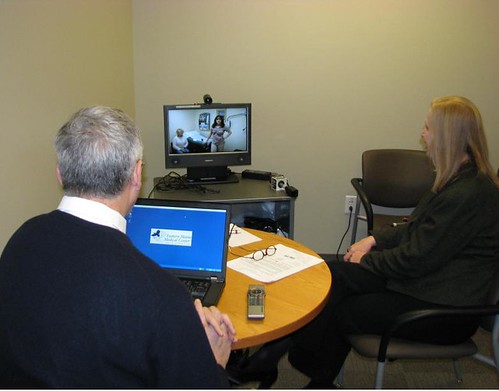Maine has one of the highest per capita rates of cancer in the United States, and for many cancer patients living in rural areas of the state, a long drive into a bigger city to receive necessary medical treatment can be daunting. Snowy Maine winters, the high cost of gasoline, relying on family or friends to drive when a patient is not feeling well, and the sheer exhaustion that comes with traveling 140 miles round trip or longer can take its toll on a cancer patient. Now, thanks in part to a USDA Rural Development Distance Learning and Telemedicine Grant, many patients will be able to receive the highest quality care and treatment without having to leave their own rural communities.
As state director of USDA Rural Development I recently met with Dr. Thomas Openshaw, Principal Investigator of Oncology Research at Eastern Maine Medical Center, at the Lafayette Family Cancer Center, in Brewer to participate in a demonstration of the service that will be provided by the telemedicine grant.

The State Director and Dr. Openshaw connected live with oncology patient Cheryl Collinsworth, a resident of Millinocket, and Family Nurse Practitioner Jackie Carter at Millinocket Regional Hospital to learn how the telemedicine technology has made life easier. Millinocket is approximately 70 miles from the Lafayette Family Cancer Center.
The impact of these services will mean less traveling for rural Maine cancer patients, helping them receive treatment within their own communities, reducing time spent away from their families, and helping them spend less time on the road and more time focusing on rest and recovery.
Cheryl told me, “The services provided by this grant will be very beneficial for patients like me who have to travel a long ways to reach an oncology specialist. This will be a time and cost saver while making sure patients like me receive high quality care and one-on-one attention without having to travel far from home.”
Dr. Thomas Openshaw said, “This technology has allowed us to better meet our patients’ needs by seeing them when they need to be seen, not when we are traveling to their medical center. We are able to hear detailed information about whatever problem or concern they have more promptly, and we are better able to assist their local care providers give them excellent care close to home.”
Eastern Maine Medical Center has more than 7,000 patients from Aroostook, Piscataquis, Penobscot, Hancock, Somerset, Washington, and northern Waldo counties receiving oncology services. This grant will assist them in expanding their telemedicine network to provide real time monitoring of cancer patients, and extend the availability of tele-oncology services, to reach six rural Maine hospitals.
USDA Rural Development is currently soliciting applications under the DLT program. For more information, click here.
